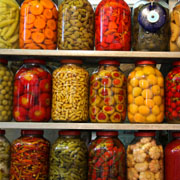IPFS

Farm Wars
Barbara Peterson
More About: FoodA Beginner's Guide to Food Storage
 Have you ever been hungry? Not just “skipped a meal” hungry, but really hungry. I am talking about the kind of hunger that won’t go away because the cupboard is bare. If you have, you will understand the need to store food. If you haven’t, this is your chance to learn from the experience of others before it happens to you, because if you run into hard times, or the store shelves run dry, you will need to have a backup supply of tasty, nutritious food.
Have you ever been hungry? Not just “skipped a meal” hungry, but really hungry. I am talking about the kind of hunger that won’t go away because the cupboard is bare. If you have, you will understand the need to store food. If you haven’t, this is your chance to learn from the experience of others before it happens to you, because if you run into hard times, or the store shelves run dry, you will need to have a backup supply of tasty, nutritious food. Food storage is not about simply stuffing a bunch of canned goods into a room and forgetting about them until you run out of food, but rather a system that focuses on creating a working food bank within your own home that is used every day by everyone in the family.
The first thing to consider when setting up your food storage system is location. Not only does your food storage area need to be dry and rather cool, but easily accessible, clean, and organized. The size of your space will depend on how much food you decide to store. This year I will convert my spare bedroom into a food storage locker. We have snow, and trudging to the pump house through three feet of snow to get supplies for dinner is not something I like doing.
Next, consider how you will store your food. Canned foods are already sealed, but dried foods need to be in rodent and insect-proof containers, and everything needs to be labeled with the contents as well as the expiration date.
Organize your food according to size, contents, and expiration date, with the food that needs to be eaten first in front, and heavier containers closest to the floor. Make sure that you create walkways so that you can easily access all of your stored items.
What you store depends on meal planning. If you don’t plan your meals, you will get into the rut of eating the same things repeatedly, because you have not adequately prepared for diversity.
If your family does not like the foods you store, they will not eat them. Therefore, meal planning is crucial in determining just what needs to be stored. But this does not have to be a chore. Get the family involved in planning meals, and have fun with it. Here is a handy printable sample chart to help plan weekly meals:
Remember: When planning your meals, a balanced diet is essential!
Once you plan a menu for the week, list the ingredients for each meal, and calculate the weekly quantities that you will need to use. For instance, if you decide to eat spaghetti for two meals during the week and use one pound of spaghetti for each meal, you will need two pounds of spaghetti for one week.
Now, take that figure and multiply it by how many weeks you plan to use that meal schedule. If you plan to store one year’s worth of food, and to eat spaghetti twice a week for each and every week of the year, you will need to multiply your two pounds of spaghetti by the number of weeks in a year, which is approximately 48, and store 96 pounds of spaghetti to cover those meals.
Do this for all of the ingredients in each meal included in the weekly food schedules that you created for your food storage program. You will now have a detailed and realistic list of food storage items along with quantities needed for the year, or several months, or for however long you plan to store food.
Once this is accomplished, the only time revisions are necessary is if a recipe has changed, there is an increase or decrease in the amount of food you need, or menus have changed. Also, make sure that you account for changing tastes and growing kids.
Here is a handy food storage calculator that will help jump-start you on your journey. These are only basic guidelines, and each family will need to make adjustments for personal preferences and needs by referring to the more detailed meal planning charts suggested previously:
The following tips will help maintain your food storage supply:
Make a checklist of your stored food items and revise it as necessary.Keep the checklist handy so that you know how much food you have on hand at all times, and what you need to replace.Check your stored items regularly for contamination and date of expiration.Resist the temptation to reach for a goody in the back of the cupboard, and always use the oldest items first.Replace what you use, placing the new items at the back of the shelf. This way you will always have your supply topped off in the event of an emergency.
Food storage is the central focus of a lifestyle that revolves around independence and sustainability. With a little planning and some work, a realistic and user-friendly food storage system can be incorporated into everyday life. So, set up your system so that you can easily use the items in front for everyday meals, get the kids involved, and have fun!























